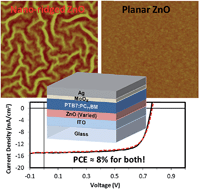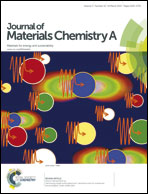High efficiency PTB7-based inverted organic photovoltaics on nano-ridged and planar zinc oxide electron transport layers†
Abstract
Inverted organic photovoltaics (OPVs) have gained considerable attention as they offer increased device stability and processing advantages. ZnO serves as an effective electron transport layer (ETL) in inverted OPVs while efficiently blocking holes. In this work, the sol–gel precursor concentration, spin coating speed and baking conditions were used to simultaneously control the film thickness and morphology of ZnO ETLs in inverted devices using the active layer of poly thieno[3,4-b]thiophene/benzodithiophene (PTB7):[6,6]-phenyl C71-butyric acid methyl ester (PC71BM) bulk heterojunction (BHJ). Nano-ridged and planar structures of ZnO films were obtained simply by dynamically and statically baking the precursor films, respectively. Consistently high FFs exceeding 70% and PCEs averaging 7.65–8.01% with a maximum PCE reaching 8.32% were achieved on both nano-ridged and planar ZnO films when the active layer was maintained at ∼94 nm. The effects of ZnO film thickness and morphology, along with the active layer thickness, on the device performance were further investigated using both experimental and transfer matrix optical modeling methods. The results demonstrated that high efficiency PTB7-based inverted OPVs can be achieved on both nano-ridged and planar ZnO ETLs as long as the optimal active layer thickness is maintained.


 Please wait while we load your content...
Please wait while we load your content...